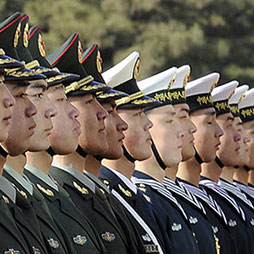Book from the People's Liberation Army Conference
Foreword to The PLA in a Complex Security Environment: Preparing for High Winds and Choppy Waters
This is the foreword to The PLA in a Complex Security Environment: Preparing for High Winds and Choppy Waters.
I am honored to present The PLA in a Complex Security Environment: Preparing for High Winds and Choppy Waters, the latest volume from an essential conference series on the Chinese People’s Liberation Army (PLA) convened by the National Bureau of Asian Research (NBR), the China Strategic Focus Group at United States Indo-Pacific Command, and the University of Virginia’s Miller Center of Public Affairs. This volume explores how the Chinese Communist Party (CCP) is thinking about the use of force in an increasingly complex security environment and assesses the CCP’s capability to employ the PLA to achieve its strategic objectives. The superb work of the authors provides a rigorous and insightful assessment of how CCP threat assessments are driving the PLA’s modernization efforts, strategy, and operational posture.
China continues its aggressive military buildup through a rising defense budget, a rapidly modernizing conventional force, an exponential increase in space-based capabilities, and an alarming nuclear weapons expansion. Beijing also continues to wage increasingly aggressive gray-zone operations against U.S. allies and partners in the Indo-Pacific region, significantly raising the risk of an incident or miscalculation that could lead to loss of life or spark a wider conflict. In the Taiwan Strait, Beijing is employing all elements of comprehensive national power to coerce Taiwan and the international community to accept that unification is, in fact, inevitable. Although China claims it prefers to achieve unification through peaceful means, Xi Jinping will not renounce the use of force. These actions pose an important question for the U.S. Department of Defense, interagency, and broader China-watching community: to what extent is Xi preparing China for war?
This PLA Conference volume contributes to the expanding global conversation on China strategic intentions by examining the CCP’s perceptions of China’s external security environment and tracing how these judgments direct whole-of-society preparations for intensifying strategic competition with the United States. It offers unique insights into the primary ideological lens through which Beijing assesses its security environment, as well as the impacts these assessments have on party-army relations. The volume then leverages this context to explore how the PLA’s missions, strategy, and operational posture are evolving along with whole-of-society efforts to compete with the West. It also examines the lessons the PLA may be drawing from Russia’s invasion of Ukraine, including how the PLA may be applying these lessons to its assessments of its own strengths and weaknesses. Finally, the volume assesses three operational theaters—Taiwan, Southeast Asia, and Oceania—and the future role of the PLA in achieving its objectives in each.
This work offers insights for understanding China’s strategic approach to military modernization for potential unification by force that planners, policymakers, and warfighters can leverage toward designing effective and achievable objectives. I am proud to sponsor this conference, and I commend the organizers and participants who contributed their collective discernment to make this volume possible.
Admiral Samuel J. Paparo is Commander of the United States Indo-Pacific Command.



